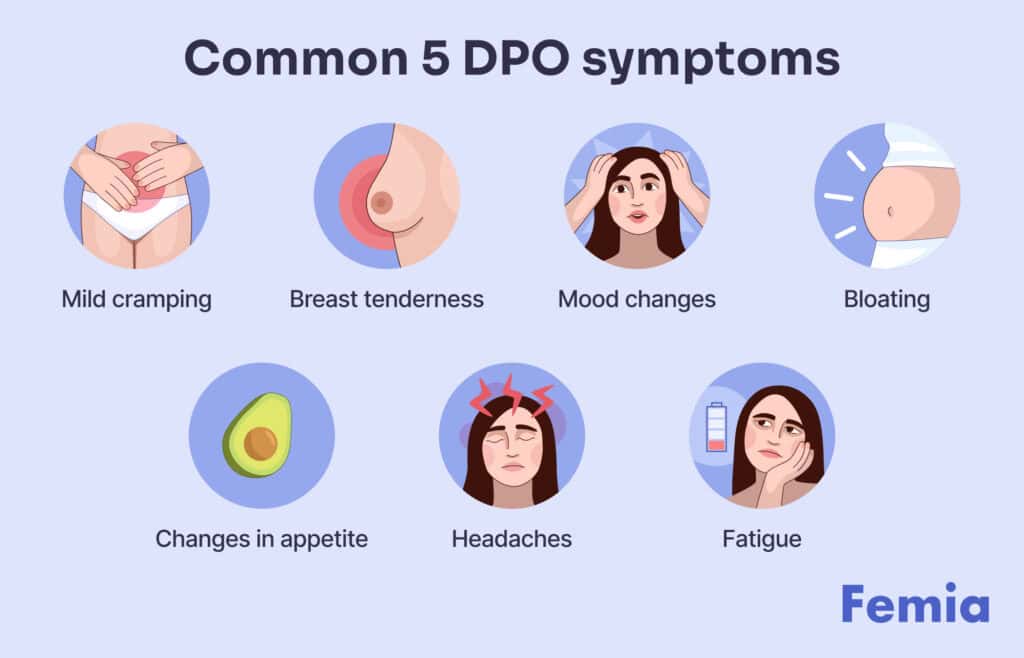5 DPO: Symptoms, Early Signs, and When to Test for Pregnancy

Key points
- Mild Cramping: Light cramping in the lower abdomen or back can be due to hormonal shifts and the uterus preparing for potential implantation.
- Breast Tenderness: Progesterone can cause your breasts to feel sore, heavy, or sensitive.
- Fatigue: Rising hormone levels can leave you feeling more tired than usual.
- Bloating and Constipation: Progesterone relaxes the muscles of your digestive tract, which can slow things down.
- Mood Swings: The hormonal fluctuations during the luteal phase can affect your emotions, much like with PMS.
- Headaches: Hormonal changes are a common trigger for headaches.
Navigating the time after ovulation can be filled with anticipation and a heightened awareness of every little change in your body. At 5 days past ovulation (DPO), you are deep in the "two-week wait," a period often marked by hope and speculation. While you may be eager for any sign of pregnancy, it's important to understand what's truly happening in your body and what to expect.
This comprehensive guide synthesizes medical information and expert consensus to answer your most pressing questions about 5 DPO, from physiological changes to the reliability of symptoms and when you can realistically take a pregnancy test.
What's Happening in Your Body at 5 DPO?
To understand what's happening at 5 DPO, it's helpful to know where you are in your menstrual cycle. You are in the middle of the luteal phase, which begins right after ovulation and ends with either a pregnancy or your period.
During this time, a temporary gland called the corpus luteum releases the hormone progesterone. This hormone's primary job is to thicken your uterine lining (endometrium) to create a welcoming environment for a fertilized egg.
If conception occurred, the fertilized egg, now called a blastocyst, is making a crucial journey. It's traveling from the fallopian tube toward the uterus. According to experts at Oova Life, at 5 DPO, the blastocyst "has reached the uterus, but likely won’t start the process of implantation for at least another day." Implantation, the process where the blastocyst attaches to the uterine wall, typically occurs between 6 and 12 DPO. This is the event that officially marks the beginning of a pregnancy.
 Image Source: Femia Health
Image Source: Femia Health
Common Symptoms at 5 Days Past Ovulation
Many people report experiencing various symptoms at 5 DPO. However, it's crucial to recognize that these signs are almost always caused by the surge of progesterone that happens in every luteal phase, not by pregnancy-specific hormones. This is why early pregnancy symptoms and premenstrual syndrome (PMS) are notoriously similar.
Common symptoms reported at 5 DPO include:
- Mild Cramping: Light cramping in the lower abdomen or back can be due to hormonal shifts and the uterus preparing for potential implantation.
- Breast Tenderness: Progesterone can cause your breasts to feel sore, heavy, or sensitive.
- Fatigue: Rising hormone levels can leave you feeling more tired than usual.
- Bloating and Constipation: Progesterone relaxes the muscles of your digestive tract, which can slow things down.
- Mood Swings: The hormonal fluctuations during the luteal phase can affect your emotions, much like with PMS.
- Headaches: Hormonal changes are a common trigger for headaches.
- Nausea: Some individuals are sensitive to the rise in progesterone and may feel mild nausea.
- Changes in Cervical Mucus: Your cervical mucus may become thick, creamy, or white due to progesterone.
Are These Signs of Pregnancy or PMS?
At 5 DPO, it is nearly impossible to distinguish between early pregnancy signs and PMS. True pregnancy symptoms are triggered by human chorionic gonadotropin (hCG), a hormone that your body only begins producing after the blastocyst has successfully implanted in the uterine wall. Since implantation has likely not happened yet, any symptoms you feel are attributable to progesterone.
Can Implantation Occur at 5 DPO?
While the typical window for implantation is 6 to 12 days after ovulation, some online forums and communities feature anecdotal stories of implantation happening as early as 5 DPO. Medically, this is considered very rare but not impossible.
If implantation were to occur this early, you might experience:
- Implantation Cramping: Often described as a mild pulling, pricking, or tingling sensation that is less intense than period cramps.
- Implantation Bleeding: According to the National Institute of Child Health and Human Development, about 25% of people experience slight bleeding or spotting around implantation. It's typically light pink or brown and lasts only a day or two.
However, it's more probable that these signs, if they appear, will occur in the coming days.
What if You Have No Symptoms at 5 DPO?
If you don't feel anything at 5 DPO, don't worry. This is completely normal. As health platform Flo points out, it is still very early to feel any different, and the absence of symptoms has no bearing on whether you have successfully conceived. Many people experience no noticeable symptoms in early pregnancy and go on to have healthy pregnancies.
Testing for Pregnancy at 5 DPO
It can be incredibly tempting to take a pregnancy test at the first hint of a symptom, but at 5 DPO, it is too early for a reliable result.
Home pregnancy tests work by detecting hCG in your urine. At 5 DPO, even in the rare case of early implantation, the levels of this hormone would be far too low to be detected. Taking a test now will almost certainly result in a false negative, which can cause unnecessary disappointment.
When Is the Best Time to Test?
For the most accurate result, medical professionals, including the U.S. Food & Drug Administration (FDA), recommend waiting until the first day of your missed period. At this point, hCG levels are typically high enough for a standard home test to detect. If you use an early-detection test, waiting until at least 10-12 DPO can increase accuracy, but the risk of a false negative is still present.
Navigating the Two-Week Wait
The period between ovulation and a potential positive pregnancy test can be emotionally challenging. Here are a few tips to help you through it:
- Focus on Self-Care: Prioritize your well-being with gentle exercise, nutritious food, and adequate sleep.
- Stay Hydrated: Drinking plenty of water is always beneficial for your overall health.
- Continue Prenatals: If you are trying to conceive, continue taking your prenatal vitamins as they contain essential nutrients like folic acid.
- Find Healthy Distractions: Engage in hobbies, spend time with loved ones, or focus on a project to keep your mind from fixating on symptom-spotting.
- Trust the Process: Remember that what you're feeling is likely due to normal hormonal cycles. Try to be patient with your body and avoid reading into every sensation.
By understanding the science behind the two-week wait, you can manage your expectations and approach this time with greater peace of mind.
Disclaimer: This article is for informational purposes only and does not constitute medical advice. Always consult with a healthcare professional for any health concerns or before making any decisions related to your health or treatment.
References
- Medical News Today. (2020). 5 DPO: Early symptoms and when to take a pregnancy test. https://www.medicalnewstoday.com/articles/322696
- Flo Health. (2023). 5 DPO: Are there any pregnancy symptoms 5 days past ovulation?. https://flo.health/getting-pregnant/trying-to-conceive/signs-of-pregnancy/5-dpo-pregnancy-symptoms
- Oova Life. 5 DPO Symptoms: What Should You Expect?. https://www.oova.life/blog/5-dpo
- National Institute of Child Health and Human Development. (n.d.). What are some common signs of pregnancy?. https://www.nichd.nih.gov/health/topics/pregnancy/conditioninfo/signs
- U.S. Food & Drug Administration. (2019). Pregnancy. https://www.fda.gov/medical-devices/home-use-tests/pregnancy

About the author
Sofia Rossi, MD, is a board-certified obstetrician-gynecologist with over 15 years of experience in high-risk pregnancies and reproductive health. She is a clinical professor at a top New York medical school and an attending physician at a university hospital.